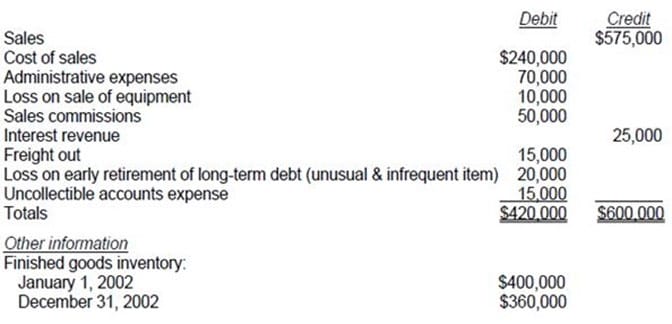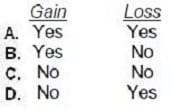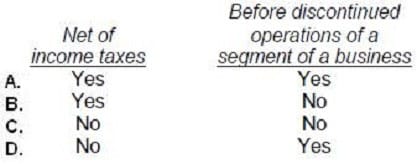Exam Details
Exam Code
:FINANCIAL-ACCOUNTING-AND-REPORTINGExam Name
:Financial ReportingCertification
:Test Prep CertificationsVendor
:Test PrepTotal Questions
:163 Q&AsLast Updated
:Apr 14, 2025
Test Prep Test Prep Certifications FINANCIAL-ACCOUNTING-AND-REPORTING Questions & Answers
-
Question 131:
Foy Corp. failed to accrue warranty costs of $50,000 in its December 31, 1992, financial statements. In addition, a $30,000 change from straight-line to accelerated depreciation was made at the beginning of 1993. Both the $50,000 and the $30,000 are net of related income taxes. What amount should Foy report as prior period adjustments in 1993?
A. $0
B. $30,000
C. $50,000
D. $80,000
-
Question 132:
The following question is based on the following:
Vane Co.'s trial balance of income statement accounts for the year ended December 31, 2002, included
the following:

Vane's income tax rate is 30%.
In Vane's 2002 multiple-step income statement, what amount should Vane report as income from
continuing operations?
A. $126,000
B. $129,500
C. $140,000
D. $147,000
-
Question 133:
The effect of a material transaction that is infrequent in occurrence but not unusual in nature should be presented separately as a component of income from continuing operations when the transaction results in
a:
A.
Option A
B.
Option B
C.
Option C
D.
Option D

-
Question 134:
An extraordinary item should be reported separately on the income statement as a component of income:

A. Option A
B. Option B
C. Option C
D. Option D
-
Question 135:
On January 2, 20X5, to better reflect the variable use of its only machine, Holly, Inc. elected to change its method of depreciation from the straight-line method to the units of production method. The original cost of the machine on January 2, 20X3, was $50,000, and its estimated life was 10 years. Holly estimates that the machine's total life is 50,000 machine hours. Machine hours usage was 8,500 during 20X4 and 3,500 during 20X3. Holly's income tax rate is 30%. Holly should report the accounting change in its 20X5 financial statements as a(n):
A. Cumulative effect of a change in accounting principle of $2,000 in its income statement.
B. Adjustment to beginning retained earnings of $2,000.
C. Cumulative effect of a change in accounting principle of $1,400 in its income statement.
D. None of the above.
-
Question 136:
A material loss should be presented separately as a component of income from continuing operations when it is:
A. An extraordinary item.
B. A cumulative effect type change in accounting principle.
C. Unusual in nature and infrequent in occurrence.
D. Not unusual in nature but infrequent in occurrence.
-
Question 137:
Lore Co. changed from the cash basis of accounting to the accrual basis of accounting during 1994. The cumulative effect of this change should be reported in Lore's 1994 financial statements as a:
A. Prior period adjustment resulting from the correction of an error.
B. Prior period adjustment resulting from the change in accounting principle.
C. Component of income before extraordinary item.
D. Component of income after extraordinary item.
-
Question 138:
In open market transactions, Gold Corp. simultaneously sold its long-term investment in Iron Corp. bonds and purchased its own outstanding bonds. The broker remitted the net cash from the two transactions. Gold's gain on the purchase of its own bonds exceeded its loss on the sale of the Iron bonds. Assume the transaction to purchase its own outstanding bonds is unusual in nature and has occurred infrequently. Gold should report the:
A. Net effect of the two transactions as an extraordinary gain.
B. Net effect of the two transactions in income before extraordinary items.
C. Effect of its own bond transaction gain in income before extraordinary items, and report the Iron bond transaction as an extraordinary loss.
D. Effect of its own bond transaction as an extraordinary gain, and report the Iron bond transaction loss in income before extraordinary items.
-
Question 139:
In September 1996, Koff Co.'s operating plant was destroyed by an earthquake. Earthquakes are rare in the area in which the plant was located. The portion of the resultant loss not covered by insurance was $700,000. Koff's income tax rate for 1996 was 40%. In its 1996 income statement, what amount should Koff report as extraordinary loss?
A. $0
B. $280,000
C. $420,000
D. $700,000
-
Question 140:
In April 30, 20X4, Deer Corp. approved a plan to dispose of a component of its business. For the period January 1 through April 30, 20X4, the component had revenues of $500,000 and expenses of $800,000. The assets of the component were sold on October 15, 20X4 at a loss. In its income statement for the year ended December 31, 20X4, how should Deer report the component's operations from January 1 to April 30, 20X4?
A. $500,000 and $800,000 should be included with revenues and expenses, respectively, as part of continuing operations.
B. $300,000 should be reported as part of the loss on disposal of a component and included as part of continuing operations.
C. $300,000 should be reported as an extraordinary loss.
D. $300,000 should be reported as a loss from operations of a component and included in loss from discontinued operations.
Related Exams:
AACD
American Academy of Cosmetic DentistryACLS
Advanced Cardiac Life SupportASSET
ASSET Short Placement Tests Developed by ACTASSET-TEST
ASSET Short Placement Tests Developed by ACTBUSINESS-ENVIRONMENT-AND-CONCEPTS
Certified Public Accountant (Business Environment amd Concepts)CBEST-SECTION-1
California Basic Educational Skills Test - MathCBEST-SECTION-2
California Basic Educational Skills Test - ReadingCCE-CCC
Certified Cost Consultant / Cost Engineer (AACE International)CGFM
Certified Government Financial ManagerCGFNS
Commission on Graduates of Foreign Nursing Schools
Tips on How to Prepare for the Exams
Nowadays, the certification exams become more and more important and required by more and more enterprises when applying for a job. But how to prepare for the exam effectively? How to prepare for the exam in a short time with less efforts? How to get a ideal result and how to find the most reliable resources? Here on Vcedump.com, you will find all the answers. Vcedump.com provide not only Test Prep exam questions, answers and explanations but also complete assistance on your exam preparation and certification application. If you are confused on your FINANCIAL-ACCOUNTING-AND-REPORTING exam preparations and Test Prep certification application, do not hesitate to visit our Vcedump.com to find your solutions here.
